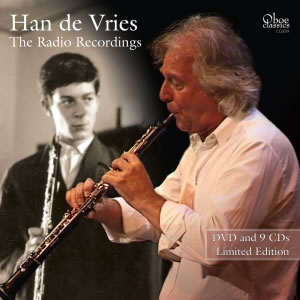It will happen to you. At 70e they honour you with a CD box set, five years later you are offered a compilation twice as bulky. It happened to Dutch oboist Han de Vries (The Hague, 1941), who celebrated his 75th anniversary last August.e birthday. In 2011, his former student Peter Bree collected the radio recordings on nine CDs, this time he filled a box with no less than 18 discs. You can imagine less grand birthday presents. Witness the title Han de Vries: the almost last recordings there is even more in store for its next anniversary.
Together, the - barely overlapping - boxes give a good idea of De Vries' enormous versatility. Starting as first oboist in the Concertgebouw Orchestra, he soon spread his wings for an impressive solo career. Embracing both authentic performance practice and cutting-edge music, he plays a baroque oboe as easily as a modern instrument.
He is considered the leading exponent of the Dutch oboe school and worked with legendary musicians such as soprano Elly Ameling, violinist Philip Hirschhorn and flautist Frans Vester. Composers such as Louis Andriessen, Bruno Maderna and Morton Feldman composed works for him. In 1959, he founded the Netherlands Wind Ensemble, currently led by his former pupil Bart Schneemann.
Snake charmer
As on the first box, both classical repertoire and modern music are amply represented. Too bad an index is missing, so you have to keep walking past all the CDs to see what's on them. In terms of early music, there is a lot of Telemann, Vivaldi and Handel, but also Bach and Albinoni. They are alongside lesser-known composers like Johann Melchior Molter and Gottfried Finger, played on baroque oboe or not.
As for more contemporary music, there are gems by Toru Takemitsu, for example. His atypical Gémeaux: I. Strophe for oboe, trombone and symphony orchestra is certainly witty. The pioneering Sequenza VII for oboe solo from Luciano Berio gets a virtuoso performance, but unfortunately its eloquence is somewhat lost in the icebreaker's pitch-dry acoustics. In Oboe and Orchestra by Morton Feldman, De Vries shows himself to be a true snake charmer of a mysteriously rumbling orchestra.
Slender tone with silver edge
There are also fine performances of compositions by Bruno Maderna, Willem Breuker and Jacques Ibert. But whatever pieces De Vries plays, there is always that slender, penetrating tone. This is aptly characterised by Peter Bree as 'the clear sound with a silver lining'. Nowadays, this typically Dutch sound is said to have been supplanted by an 'international oboe sound that is darker in nature'. Whether we should regret this is a matter of taste; personally, I do like a nice round sound.
Not all pieces and performances are of the same high standard. For example, a performance of In C by Terry Riley somewhat plodding. It lacks the nimbleness we associate with the rousing piece with which the American launched minimalism in 1964. The recorded compositions by lesser gods such as Charles Martin Loeffler, Paul Hindemith or Alexandre Tansman are lacking in sparkle, but on the other hand, Richard Strauss's intensely lyrical oboe concerto is the opposite.
On the first box, this recording was still copied from a cassette tape, meanwhile the original tapes were found. The sound is more transparent, but the more homogeneous sound of the old recording has a charm all its own.
For oboe lovers, this new box is just as much a must as the earlier ones. Enjoy browsing through early, classical, romantic, and modern music with an inspired and skilled guide like Han de Vries.

